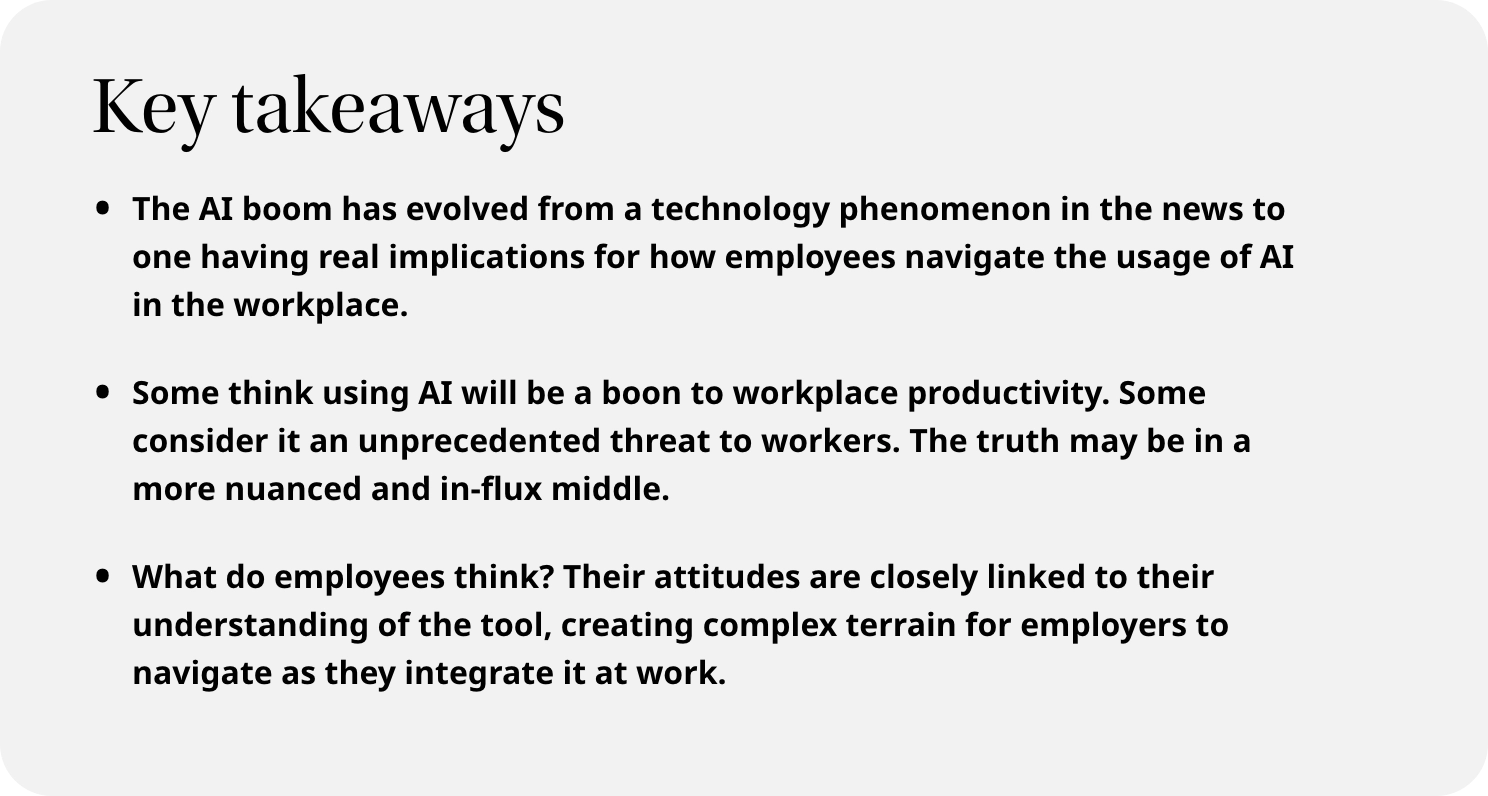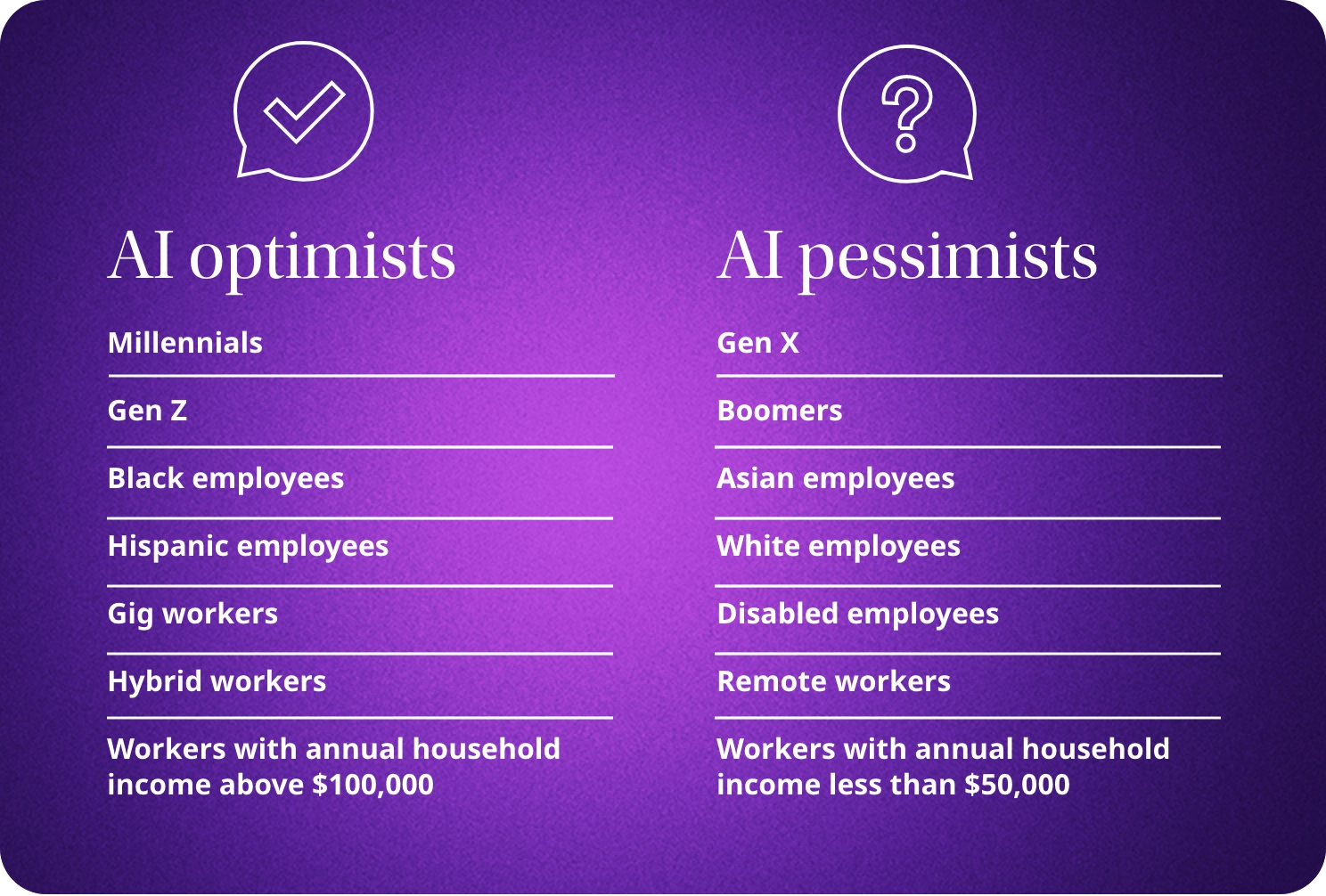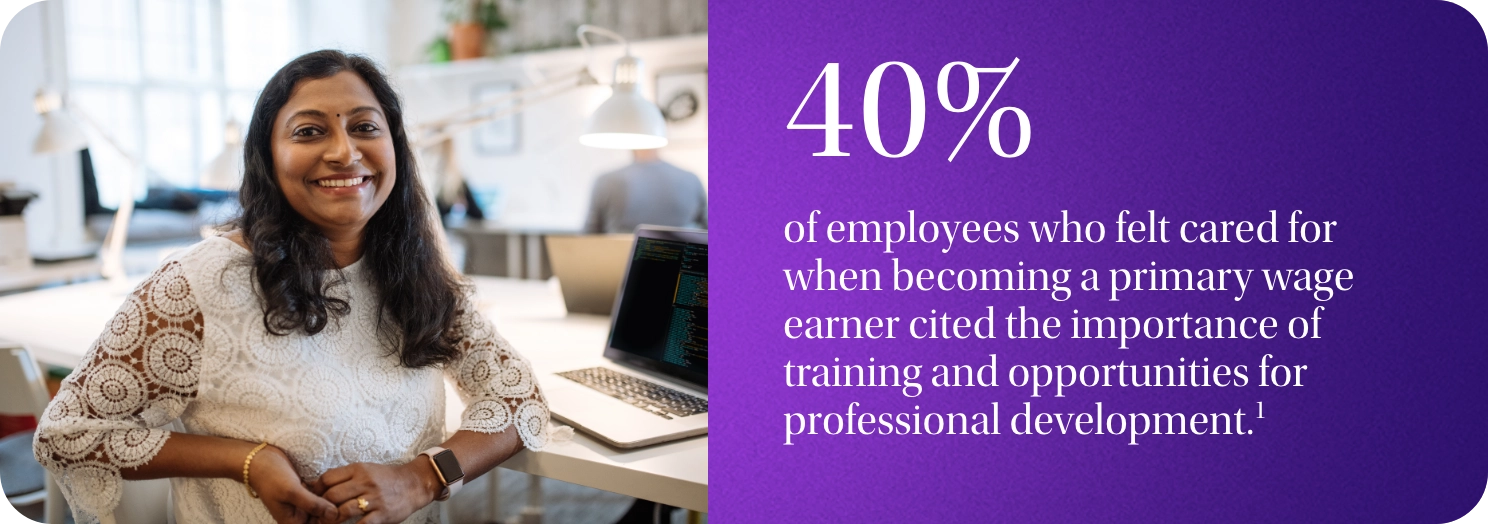Eyebrow
The robot overlords haven’t arrived but they’re on their way.
Is there anything of recent vintage that’s been the subject of more feverish speculation than artificial intelligence? As AI stocks bound into the stratosphere and pundits predict everything from a new world order to the end of life as we know it, there are as many questions as there are answers about what this tantalizing new technology means for our collective future. But it’s clear that we’ve gone from “it’s hype” to “it’s here” faster than any of us dared imagine.
Perhaps no where is this more evident than in all the buzz that surrounds using AI at work. For workers, the question is existential: is AI going to free me to be my best self and reach my full potential as an employee or will it negatively affect my career and future job prospects?
That question has real—and unsettling—resonance for workers across the job spectrum. Take the heated battle in Hollywood that recently pitted SAG-AFTRA performers and writers on one side against the Alliance of Motion Picture and Television Producers on the other. With streaming services rapidly disrupting the economics of the entertainment business, among the most bitter sources of contention was the potential impact of AI on the jobs—and wages—of writers and performers.
On the other hand, there’s no question that AI—and particularly generative AI has the potential to enhance workplace productivity in ways that we are only beginning to scratch the surface of. The economic implications are astonishing. A recent report by McKinsey estimates that generative AI’s impact on productivity could add trillions of dollars in value to the global economy.1
So, is AI friend or foe? Maybe frenemy is more like it—and a better way to describe how employees feel.
“Help me do my job, but don’t take my job.”
Maybe that verbatim response from our 2024 Employer Benefit Trends Study best sums up the ambivalence employees feel toward using AI in the workplace. As if lingering economic anxiety,raging geopolitical conflicts, and what may be the most divisive and tumultuous election year in history wasn’t enough, ongoing technology disruption, including the workplace expansion of AI isstressing workers like never before. Among the myriad challenges that companies face is workerstress. Some 55% of employers report employee stress as one of the top challenges they face.2
For the first time, our research explored employee attitudes toward AI and revealed a broad spectrum of attitudes toward it. For example, more workers are optimistic about how AI will impact their careers than pessimistic. But while a significant portion of the workforce reported a good understanding of AI, that wasn’t true across the board. Over half of men said they understand AI, but only a little more than a third of women said they understood it. The EBTS also showed a clear and consistent correlation between understanding of AI and feelings toward it,with opinions that fracture across generational, ethnic, and household income divides.
The importance of care in a transformed environment.
Always-on strategies play a key role in helping employees feel more secure in the wake of unexpected workplace developments. By employing always-on care, employers can be ready to provide the support employees need in situations that don’t conform to fixed timelines and may last for extended periods. Arguably, a disruptive technology like AI falls into that category as organizations figure out how to integrate it into the workplace.
During these times of change, investing in benefits, programs and resources can play a key role in providing the always-on care employees expect. Here are just a few strategies employers can use to deliver always-on care in the face of AI:
- Provide training and development so employees can access the information they need to navigate new technologies or policies
- Focus on providing a psychologically safe environment, where employees feel free to voice their needs, and are comfortable using all the resources that employers make available to them
- Demonstrate empathy to make employees feel seen and valued as individuals so that they feel their concerns and needs will be understood
So, it makes sense that providing robust training is a critical part of preparing employees for the brave new world of AI and must be a part of the overall care that a company provides. Simply making the training available, however, doesn’t go far enough. Employees are more likely to access resources that are available to them—such as training—if they know it is okay to ask for support when they need it. Workers must feel comfortable taking the time and exerting the effort necessary to take advantage of such training which usually must be taken on in addition to their normal daily duties. Employers must do their part to ease the stress of heavy workloads and managerial in difference to help clear the path for employee learning and development.
AI is here to stay, but whether that stay is seen as a welcome addition or a threatening intrusion depends largely on how organizations choose to manage it. The importance of intentionality and transparency about implementing AI in the workplace in a way that calms worker anxiety cannot be overstated. The rewards, in increased productivity, a more skilled and efficient workforce, andan organization more technologically prepared to compete, will benefit both employer and employee alike in the years ahead. To learn more about attitudes toward AI in the workplace as well as how companies can deliver care across the entire employee experience to smooth its acceptance, download MetLife’s 2024 Employee Benefit Trends Study now.
Notes
- The economic potential of generative AI: The next productivity frontier, June 14, 2023
- 2024 MetLife Employee Benefits Trends Study
Research Methodology
MetLife’s 22nd Annual U.S. Employee Benefit Trends Study was conducted in November 2023 and consists of two distinct studies fielded by STRAT7 Rainmakers—a global strategy, insight and planning consultancy. The employer survey includes 2,595 interviews with benefits decision makers and influencers at companies with at least two employees. The employee survey consists of 2,809 interviews with full-time employees, ages 21 and over, at companies with at least two employees.
About MetLife
MetLife, Inc. (NYSE: MET), through its subsidiaries and affiliates (“MetLife”), is one of the world’s leading financial services companies, providing insurance, annuities, employee benefits and asset management to help its individual and institutional customers navigate their changing world.Founded in 1868, MetLife has operations in more than 40 countries and holds leading market positions in the United States, Japan, Latin America, Asia, Europe and the Middle East. For more information, visit www.metlife.com.
About STRAT7 Rainmakers
STRAT7 Rainmakers is a UK-based global strategy, insight and planning consultancy with a focus on delivering game-changing commercial impact. Since our inception in 2007, we’ve worked collaboratively with leading companies to help define opportunities for brands, categories and businesses. Our expertise spans not only Financial Services, but also Food and Drink, Beauty, Healthcare, Telecoms, Technology, Entertainment, and Travel. Our programs and client relationships span all continents, with 50% of our work originating in the US. In April 2023, we joined the STRAT7 group. For more information, visit www.rainmakerscsi.com.



